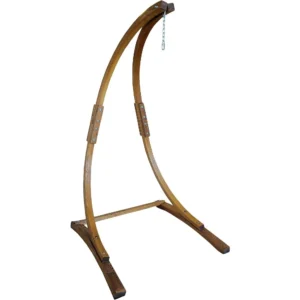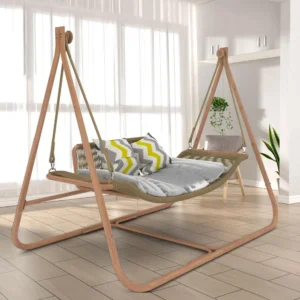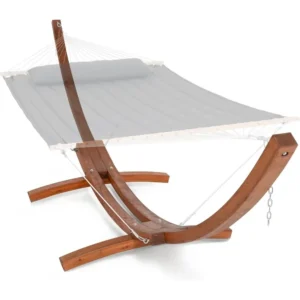Understanding Hammock Chair Weight Capacity
When choosing a hammock chair, one of the most critical specifications to consider is its weight capacity. Most hammock chairs can support between 200-500 pounds (90-225 kg), though this range varies significantly depending on design, materials, and construction quality.
Understanding weight capacity isn’t just about knowing if a chair will hold you—it’s fundamentally about safety, durability, and enjoyment. A hammock chair operating at or near its maximum capacity will wear out faster and potentially create dangerous situations if it fails.
Several key factors determine how much weight a hammock chair can safely hold:
- Material strength and quality
- Construction techniques
- Suspension system components
- Installation method
- Frame design (for chairs with stands)
Premium hammock chairs typically offer higher weight capacities, often exceeding 300 pounds, while featuring reinforced attachment points and higher-grade materials. Proper hammock chairs for covered porches must have appropriate weight capacities to ensure safe, long-term installation in these semi-permanent locations.
Types of Hammock Chairs and Their Weight Capacities
Different styles of hammock chairs come with varying weight capacities based on their design and intended use. Understanding these differences helps you select the right option for your needs.
| Hammock Chair Type | Typical Weight Capacity | Common Materials | Best For |
|---|---|---|---|
| Standard Hanging Chairs | 250-300 lbs (113-136 kg) | Cotton, polyester | Individual use, indoor/outdoor |
| Macramé Chairs | 200-275 lbs (90-125 kg) | Cotton rope, nylon | Decorative use, lighter individuals |
| Swing Chairs | 250-350 lbs (113-159 kg) | Polyester, cotton, metal frame | Active sitters, versatile use |
| Egg Chairs | 300-500 lbs (136-227 kg) | Steel frame, wicker, cushioned interior | Maximum comfort, heavier individuals |
| Wooden Frame Chairs | 275-400 lbs (125-181 kg) | Hardwood, rope, canvas | Durability, classic appearance |
The design of the chair significantly impacts its weight capacity. Egg chairs, with their enclosed design and sturdy frames, typically offer the highest capacity. In contrast, decorative macramé chairs often have lower weight limits due to their open-weave design and emphasis on aesthetics over structural support.
Our collection of hammock chairs with stands features a range of designs with various weight capacities to suit different needs. When comparing options, remember that traditional full-size hammocks often support different weight ranges than hammock chairs due to their different suspension systems and intended use patterns.
Indoor hammock chairs typically have slightly lower weight ratings than outdoor versions because they’re less likely to be exposed to environmental stressors and are generally designed with more decorative elements. Outdoor models prioritize durability and weather resistance, often resulting in stronger overall construction.
Critical Factors That Determine Weight Capacity
Several key elements influence how much weight a hammock chair can safely support.
Material Strength and Quality
The fabric or rope material is your primary contact point with the chair and must maintain integrity under pressure. Cotton canvas offers comfort but may stretch over time, while synthetic fabrics like polyester and nylon provide superior strength-to-weight ratios and weather resistance.
Rope quality makes a significant difference—professional-grade nylon ropes can have tensile strengths exceeding 700 pounds, while decorative cotton ropes might only reliably support 200-250 pounds before showing stress.
Construction Techniques
The way a hammock chair is assembled dramatically impacts its strength:
- Double-stitched seams can support nearly twice the weight of single-stitched versions
- Reinforced stress points (where fabric meets suspension) prevent tearing
- Proper weight distribution design spreads force across multiple support points
- Quality control testing ensures consistent performance
Suspension System Components
The components that connect your chair to its support point often determine the true weight limit:
- Steel carabiners typically support 200-800 pounds depending on quality
- Hanging ropes vary from 300-1200 pounds in breaking strength
- S-hooks are usually the weakest link, often rated for only 150-300 pounds
- Swivels and springs add convenience but can reduce overall capacity
Frame Design and Materials
For hammock chairs with stands, the frame material and design are crucial:
- Powder-coated steel frames typically support 250-400 pounds
- Hardwood frames range from 250-350 pounds depending on wood type and thickness
- Base stability design affects safe working capacity regardless of material strength
Finding hammock chair ideas for ultimate relaxation means balancing aesthetic appeal with practical considerations like weight capacity and structural integrity.
Installation Method and Its Impact on Weight Support
Even the strongest hammock chair can fail if improperly installed. Your installation method can either preserve or significantly reduce the manufacturer’s stated weight capacity.
Ceiling Mounts
Ceiling installations require careful consideration:
* Joist-mounted hooks can support 300-700 pounds when properly installed
* Drywall anchors alone typically support only 50-75 pounds—never enough for hammock chairs
* Joists running perpendicular to the desired hanging direction may require special mounting plates
Stand Installations
When using hammock chair stands:
* Base stability is equally important as vertical weight capacity
* Wider bases generally provide better support for dynamic movement
* Follow assembly instructions precisely—improper assembly can reduce capacity by 30-50%
Tree or Beam Mounting
Outdoor installations present unique considerations:
* Healthy hardwood trees over 8 inches in diameter can typically support several hundred pounds
* Use tree-friendly straps that distribute weight instead of hooks that damage bark
* Consider branch flexibility and health—dead or dying branches may fail regardless of size
Remember that the weakest point in your entire setup determines the true weight capacity. This means proper porch hammock chair installation techniques are essential for maintaining the chair’s intended weight capacity and ensuring safety.
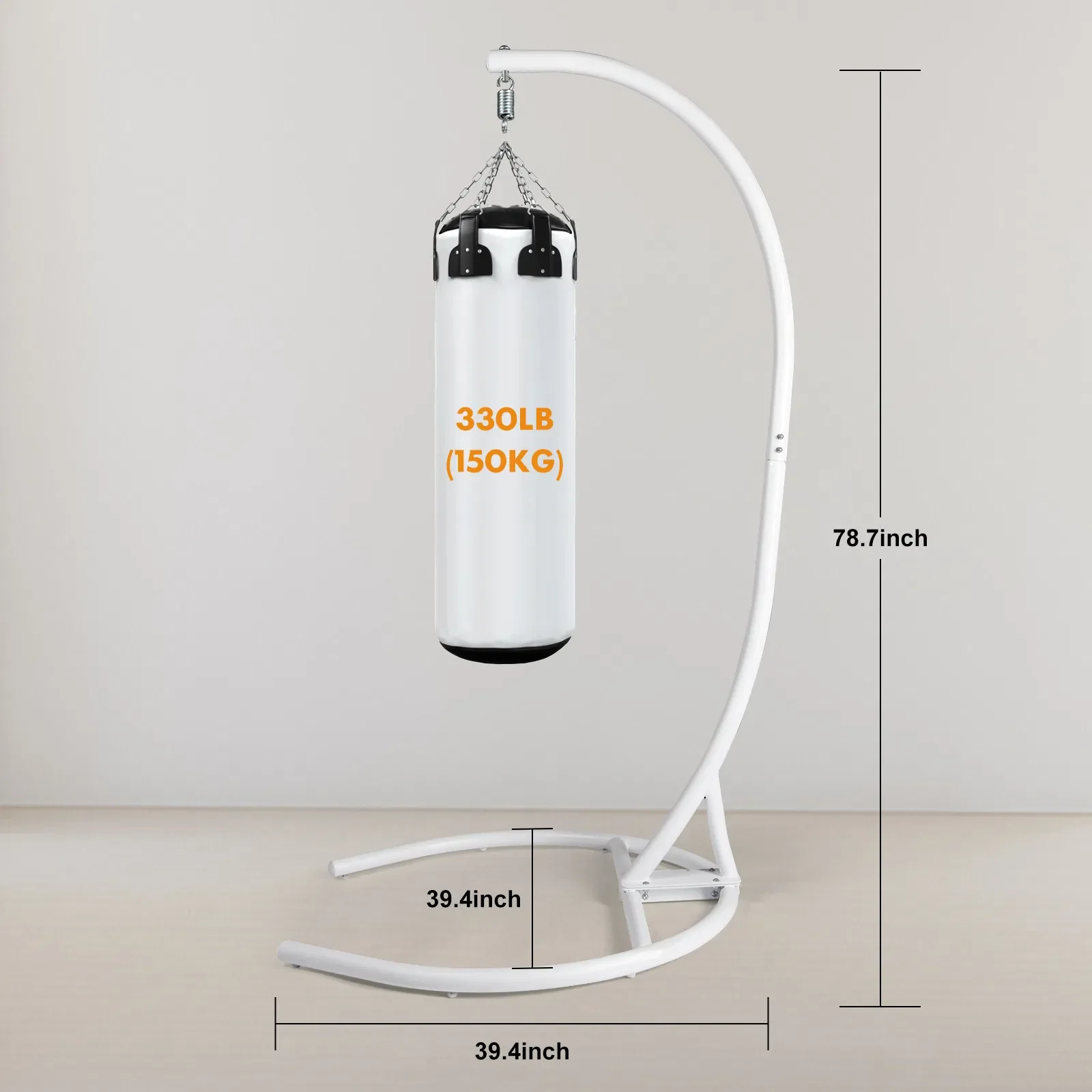
The Difference Between Static and Dynamic Weight Load
Understanding the difference between static and dynamic weight is crucial for hammock chair safety.
Static weight is the consistent pressure applied when sitting still in your hammock chair. This is typically what manufacturers list as the weight capacity.
Dynamic weight occurs when you:
* Swing or rock in the chair
* Sit down quickly or abruptly
* Shift position suddenly
* Bounce or move rhythmically
Dynamic forces can multiply the effective weight by 1.5 to 3 times the static weight. This means a 200-pound person swinging in a hammock chair could momentarily place 400-600 pounds of force on the suspension system.
Most manufacturers only specify static weight limits in their product specifications. For safety, consider the actual weight capacity to be 25-30% less than advertised to account for dynamic movements.
For those seeking additional support, our deep seat chair hammock sets provide excellent weight distribution that helps manage dynamic forces while maintaining comfort.
Signs Your Hammock Chair Is Overloaded
Being able to recognize when your hammock chair is being stressed beyond its capacity can prevent accidents and extend the life of your chair.
Watch for these warning signs:
* Visible stretching or deformation of fabric or ropes
* Creaking or popping sounds during normal use
* Fraying threads or small tears, especially at stress points
* Excessive sagging beyond the original design
* Stand legs showing signs of bending or instability
* Mounting hardware pulling away from support surfaces
Even if your chair hasn’t failed completely, consistent overloading causes cumulative damage. Materials fatigue over time, particularly with repeated stress. A chair that safely holds weight today might fail after weeks or months of being used at its maximum capacity.
Understanding how fabric hammock weight capacity works helps you identify early warning signs before dangerous failure occurs.
Weight Capacity for Special Hammock Chair Types
Special hammock chair designs often have unique weight capacity considerations worth understanding.
Double Hammock Chairs
Double chairs advertised for two people typically have weight capacities between 400-550 pounds (181-250 kg). However, be cautious about marketing claims—some “double” chairs are merely wider single chairs with standard weight limits.
True double hammock chairs feature:
* Reinforced suspension points
* Thicker, stronger support ropes or chains
* Wider fabric panels with additional stitching
* Heavier-duty frames or mounting requirements
Children’s Hammock Chairs
Chairs designed specifically for children typically support 120-180 pounds (54-82 kg). While this seems adequate for most children, remember that kids often use chairs more dynamically—swinging, bouncing, and playing—creating much higher dynamic loads.
Therapeutic Hammock Chairs
Specialized hammock chairs designed for therapeutic or sensory uses often feature reinforced construction with weight capacities of 300-400 pounds (136-181 kg) to accommodate adult supervision and provide extra safety margins.
Our swinging hammock chair sets include various designs to accommodate different weight requirements and usage patterns.
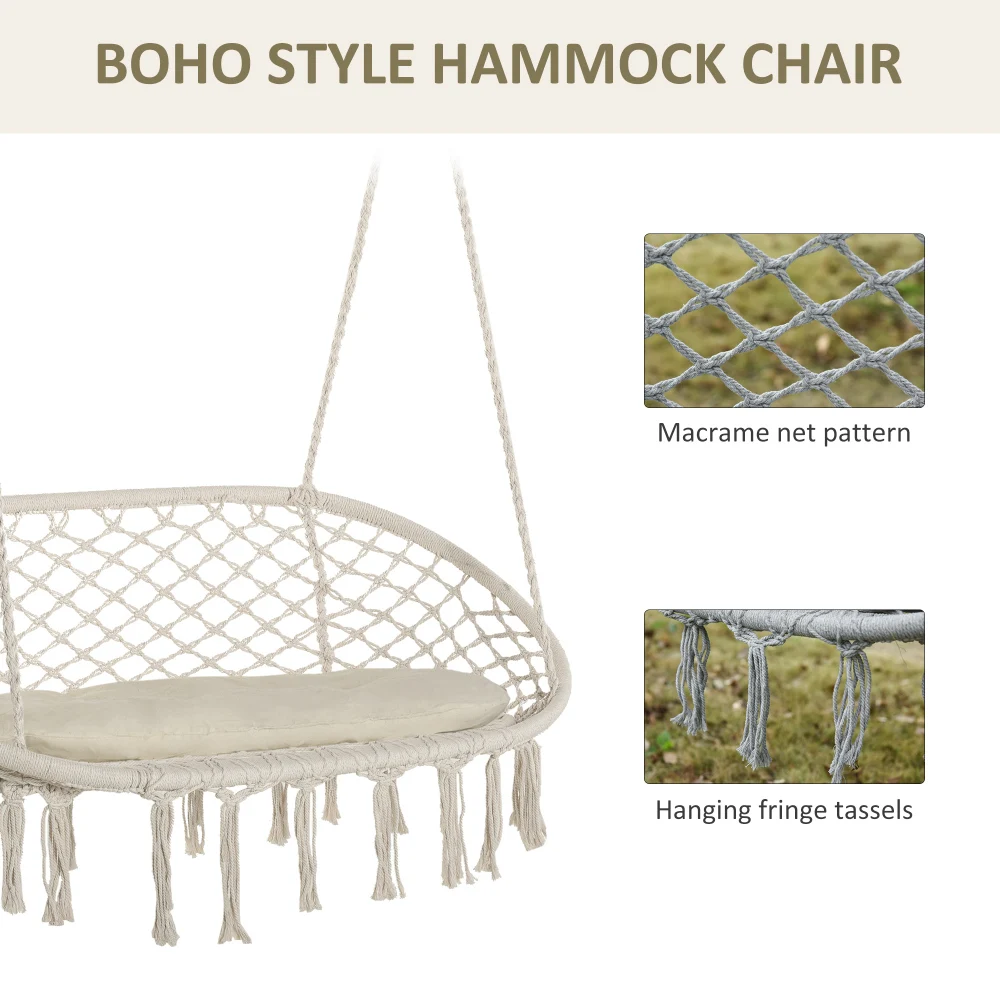
How to Verify a Hammock Chair’s True Weight Limit
Finding accurate weight capacity information requires some investigation, but it’s worth the effort for your safety.
Follow these steps to determine a hammock chair’s true weight limit:
- Check product specifications for explicitly stated weight capacities
- Look for testing certification labels or information (ASTM or similar standards)
- Read multiple product descriptions—sometimes weight limits appear in different sections
- Examine hardware ratings—carabiners and other components often have weight limits stamped on them
- Contact the manufacturer directly for verification if information is unclear
When weight capacity isn’t clearly stated, consider it a potential red flag. Quality manufacturers who’ve tested their products are typically transparent about weight limits.
For outdoor use, weather-resistant hammock chairs for porches should clearly state both their weight capacity and how environmental exposure might affect that capacity over time.
Safety Precautions for Maximum Weight Capacity
Following these safety guidelines ensures your hammock chair remains safe throughout its lifetime:
Never exceed the stated weight limit, even temporarily. Always stay at least 10-15% below the maximum rating.
Inspect your hammock chair regularly by checking:
* All connection points for wear
* Fabric for stretching or thinning
* Hardware for deformation or rust
* Suspension ropes or chains for frayingPerform maintenance proactively rather than after problems occur:
* Tighten loose hardware quarterly
* Replace worn components before they fail
* Clean according to material specificationsTest carefully after long storage periods or exposure to harsh weather by gradually applying weight.
Replace entire components at the first sign of significant wear—partial repairs often create weak points.
For users requiring exceptional durability, our heavy-duty hammock sets provide peace of mind with reinforced construction throughout.
Are Hammock Chairs Safe for Heavier Individuals?
Yes, hammock chairs can absolutely be safe and comfortable for heavier individuals when chosen carefully. Many manufacturers now produce specially designed heavy-duty hammock chairs that support 350-500 pounds (159-227 kg).
When shopping for higher-capacity hammock chairs, look for:
- Explicit “heavy-duty” or “high capacity” labeling with specific weight ratings
- Reinforced suspension points with multiple connection points
- Commercial-grade materials and hardware
- Wider sitting areas that distribute weight more effectively
- Steel frames rather than aluminum or wooden components
- Double or triple-layered fabric construction
Several specialized manufacturers offer custom options that can be built to specific weight requirements, though these typically come at premium prices.
Understanding the various names for hanging seats can help you identify products specifically designed for higher weight capacities, as certain terms are often associated with sturdier construction.
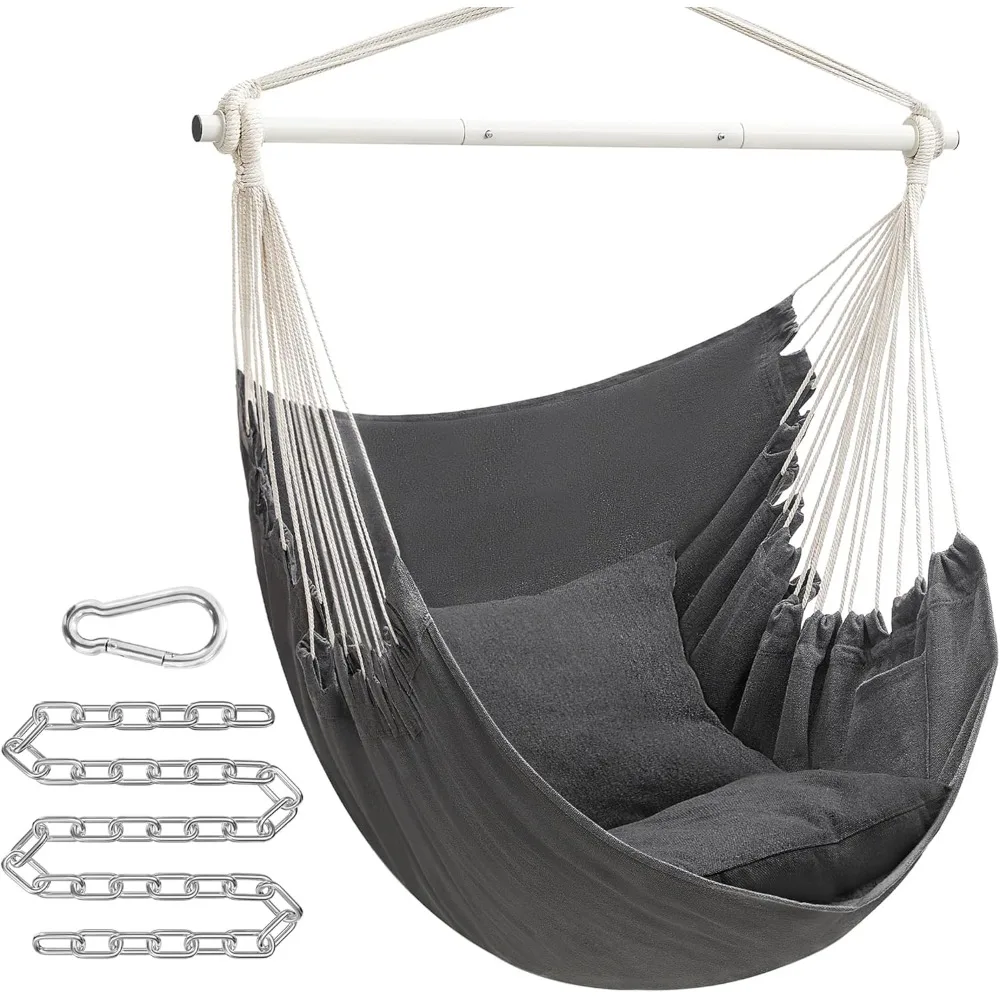
Frequently Asked Questions About Hammock Chair Weight Capacity
Can two people safely use a hammock chair designed for one?
Generally no. Even if the combined weight is within limits, single hammock chairs aren’t designed for proper weight distribution with two bodies. This creates unsafe pressure points and increases fall risk.
What happens if weight capacity is exceeded just once?
Exceeding capacity even briefly can cause invisible damage—stretched fibers, weakened connection points, and micro-tears that compromise future safety. Materials may appear fine but have significantly reduced strength.
Can I increase my hammock chair’s weight capacity?
While you can upgrade hanging hardware and reinforcement points, the fabric itself usually cannot be strengthened. Any modification creates a system only as strong as its weakest component.
How does weather exposure affect weight capacity over time?
UV rays degrade fabric strength by 15-30% annually with regular exposure. Moisture promotes mildew that weakens fibers, while temperature fluctuations stress connection points. Indoor storage when not in use is highly recommended.
Are indoor hammock chairs different from outdoor ones in terms of capacity?
Indoor hammock chairs often prioritize aesthetics over weather resistance but may still offer similar weight capacities. Outdoor versions use UV-stabilized materials that maintain their strength longer under environmental exposure.
Understanding whether you can sleep in a hammock chair relates directly to weight capacity questions, as extended use requires chairs with excellent long-term load-bearing capabilities.
Dark Wood Hammock Sets, Porch Swing Chair Sets
$653.82 Select options This product has multiple variants. The options may be chosen on the product pageA-Frame Stand Hammock Sets, Swinging Hammock Chair Sets
$154.62 Select options This product has multiple variants. The options may be chosen on the product pageLight Wood Hammock Sets, Swinging Hammock Chair Sets
$1,359.35 Select options This product has multiple variants. The options may be chosen on the product pageClassic Wooden Stand Hammock Sets, Heavy Duty Hammock Sets
$1,061.68 Select options This product has multiple variants. The options may be chosen on the product pageHammock Sets with Canopy, Heavy Duty Hammock Sets
$286.31 Select options This product has multiple variants. The options may be chosen on the product pageHeavy Duty Hammock Sets, Wooden Arc Stand Hammock Sets
$878.66 Select options This product has multiple variants. The options may be chosen on the product page
Choosing the Right Hammock Chair Based on Weight Requirements
When selecting a hammock chair with weight capacity as a primary concern, consider these factors:
Calculate your true weight needs:
* Add 50-75 pounds to your actual weight for safety margin
* Account for accessories like pillows or blankets
* Consider whether friends or family members who weigh more might use itLook beyond just meeting minimum requirements:
* Chairs operating near maximum capacity will wear out faster
* Dynamic activities require greater safety margins
* Higher capacity often correlates with better overall qualityQuality indicators that suggest better weight support:
* Marine-grade hardware
* Reinforced edge stitching
* Multiple suspension points
* Clearly stated testing protocolsWorth paying more for:
* Commercial-grade suspension systems
* Stainless steel hardware instead of zinc-plated
* Solution-dyed acrylic fabrics that maintain strength while resisting fading
For stylish options with varying capacities, browse our hanging egg chair sets that combine aesthetics with careful engineering for safety.
Maintaining Your Hammock Chair for Long-Term Safety
Regular maintenance ensures your hammock chair maintains its weight capacity over time.
Inspection Schedule
- Weekly: Quick visual check of main connection points
- Monthly: Thorough examination of all components
- Seasonally: Complete hardware tightening and deep cleaning
Critical Maintenance Tasks
- Wash fabric according to manufacturer instructions to remove weakening contaminants
- Protect from UV exposure when not in use
- Replace hardware showing any corrosion or deformation
- Store properly during off-seasons in climate-controlled environments
Seasonal Considerations
- Winter: Indoor storage prevents freeze-thaw stress on materials
- Spring: Check for winter damage before first use
- Summer: More frequent inspections during peak usage
- Fall: Clean thoroughly before storage to prevent material degradation
The best materials for hammock chairs on porches not only provide comfort but also maintain their structural integrity and weight capacity through seasonal changes.
Final Thoughts: Balancing Comfort and Safety
Understanding hammock chair weight capacity is essential for both safety and enjoyment. While it might be tempting to focus primarily on style or price, weight capacity directly impacts your safety and the longevity of your investment.
Always prioritize:
* Choosing chairs with clearly stated weight limits
* Installing according to manufacturer specifications
* Respecting the stated limits consistently
* Maintaining your chair properly over time
Remember that a quality hammock chair operating well within its weight capacity will provide years of comfortable, safe relaxation. The most beautiful chair is worthless if it cannot safely support its users.
For a perfect balance of style, comfort, and safety, explore our collection of porch swing chair sets designed to meet various weight requirements while enhancing your outdoor living space.


